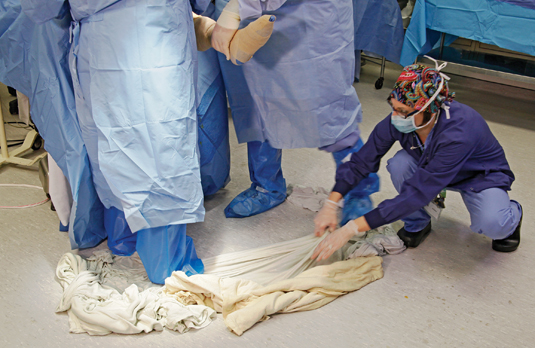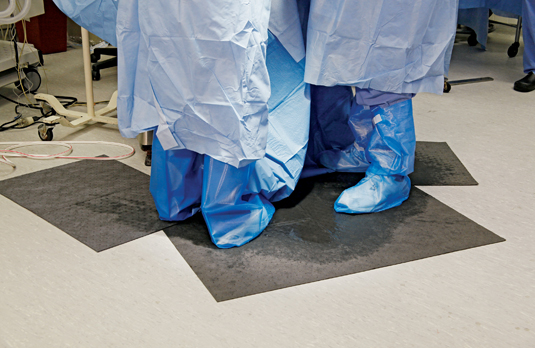Plan Ahead to Prevent Slips, Trips, and Falls
September/October 2013
![]()
Plan Ahead to Prevent Slips, Trips, and Falls
Slips, trips, and falls on flat surfaces are the leading cause of workplace injury. And, in the healthcare industry, incident rates are 90% higher than in all other private industries combined, according to the Bureau of Labor Statistics’ national census of nonfatal injuries.
Establishing a comprehensive floor safety plan that identifies problem areas and documents procedures to be followed to mitigate those hazards will help eliminate slip, trip, and fall injuries. In fact, according to Slip, Trip and Fall Injuries Among Nursing Care Facility Workers, published by the National Institute of Occupational Safety and Health (NIOSH) has shown that implementing a comprehensive slip, trip, and fall (STF) prevention program can reduce workers compensation claims by 59% (Bell et al., 2010).
Buying an entrance mat to toss near the front door when it rains or having a mop bucket in a maintenance shed is not a comprehensive plan, and is not enough to prove due diligence in the event of a slip and fall injury. Even having a stockroom full of random products that are all marketed for slip-resistance is usually not enough to solve the problem, especially if the products are difficult to use or are not designed to meet specific needs.
Identifying Hazards
With a floor plan or blueprint for the facility, begin looking outdoors for hazards in the parking lot. Weather conditions such as ice and snow, and walking surface irregularities are two of the top five STF hazards, and are common in parking lots, sidewalks, and other outdoor areas. Irregularities, such as uneven sidewalks or deep cracks that cause a surface to vary as little as one-half inch can lead to a trip and fall. Un-raked leaves and mulch that has migrated onto walkways have also been known to contribute to injuries. As hazards are identified, note them on the floor plan or blueprint.
After evaluating outdoor conditions, check entrances and common areas for these and other hazards. Inadequate lighting, especially in transition areas, is another common contributor to slip and fall injuries.
Transition areas are any areas where the walking surface changes. An example is an entranceway where the surface changes from brushed concrete to tile. Another example is a carpeted aisle that leads to linoleum in a patient’s room. Check mats and runners used in entrances and transition areas. If they are not the correct style or length; or if they are buckled or frayed, they may actually present more hazard than the bare floor surfaces.
Next, look for contaminants on any floor surface. Contaminants on the floor are the leading cause of STF injuries. Common floor contaminants in a healthcare setting include water, cleaning chemicals, and even something as small as a single aspirin.
Trip hazards are also more prevalent in healthcare settings than in general industry. Loose cords, hoses, wires, and tubing are often present in operating rooms, patient room, hallways, and other areas.

Before (left): Blankets on wet operating room floors and patient areas add to slip, trip and fall hazards.

After (right): Absorbent mats quickly absorb liquids and stay flat to keep floors safer.
Courtesy of New Pig
Creating a Plan
To create an initial STF prevention plan, gather input from multiple areas. Maintenance staff members, floor supervisors, and insurance claim personnel may be among the team members. Because they work or service specific areas daily, they may even be able to identify additional problem areas that were not noticed during the initial walk-through.
Involving personnel from different areas will help create a plan that has realistic solutions. Sometimes, those solutions may come at little or no cost. For example, if snow in the employee parking lot is identified as a problem, the maintenance staff may be able to arrange for the contracted plowing service to plow the lot by a certain time so that the snow is removed and anti-skid material is in place half an hour before each shift change.
Where purchasing expensive floor dryers for every hallway may look impressive on paper, for small spills a more realistic solution may be to install paper towel dispensers in hallways or in each room. With the average cost of a disabling slip and fall injury costing approximately $250,000 per year, according to the National Floor Safety Institute (NFSI), the investment in paper towel dispensers will pay off if just one incident is avoided. A paper towel is also an easier and faster solution than finding and placing a heavy, noisy floor dryer every time there’s a little drip or spill.
Sometimes, more than one product or procedure may be necessary to correct a problem. For instance, a paper towel is good for small spills; but if an entire case of IV solution breaks, paper towels are not going to be practical. A clean mop and bucket, wet floor signs, and maybe a floor dryer are likely to be a better solution. Having a robust plan that documents as many different scenarios as possible and lists each employee’s responsibilities for identifying hazards, responding to spills, and reporting incidents is the key to having solutions in place that eliminate problems quickly and easily. It also helps ensure that everyone on staff is accountable for workplace floor safety.
Consider time constraints and the amount of training any proposed solutions may take. The best, most expensive anti-slip product on the market may not be an ideal choice if it is hard or takes a long time to use.
Products as Part of the Plan
Although many STF prevention solutions may come at little or no cost, not every solution will. When this is the case, it is important to get the right products for the job.
Mats can be used on different types of surfaces and for a variety of purposes. They can also be used indoors or out. Mats that are used indoors should have a damming feature to keep water and dirt in the mat so that it does not migrate onto the floor surrounding the mat and create a slip hazard. The backing on a mat is another consideration. Different backings are available for mats that will be used on carpet, tile, cement, and other surfaces.
Be cautious of mats that are provided through rental services. Most do not have damming features, and most are not long enough to thoroughly clean and dry feet. A mat needs to be at least 10 feet long to dry a person’s feet as they walk over it.
Floor cleaning products and maintenance routines are an important part of floor safety. Improper floor care is a common cause of slippery floors. Improper floor care can include cleaning a floor too frequently, not cleaning it enough, not using the right type of cleaner, or using the wrong amount of cleaner. One of the most common floor care problems is using too much cleaner. This can alter the finish of the floor, or it can leave a residue that makes the floor slippery.
Signs can help increase awareness, serve as a reminder, or alert people to a situation that cannot be avoided. When considering signage, include floor cones, barricade devices, and other similar items that provide a visual indication that a hazard may be present. When non-permanent signs are part of the plan, ensure that the process for using them includes removing them promptly when the hazard is no longer present. Wet floor signage and barricades that are left up long after a floor has dried can condition people to ignore the hazard.
An area of floor safety that is sometimes overlooked is spill preparedness. More than 10,000 reportable spills occur in facilities each year, and while they most often happen at manufacturing and industrial sites, the healthcare industry is not immune to them. Consider stocking spill kits that contain absorbent mats and socks as well as goggles, gloves and any other items that would be necessary when responding to larger spills.
Maintained Diligence
A plan that is created and tucked away on a shelf is soon forgotten. It may take some effort and coordination between departments to put plans and procedures into place, but the time spent will help ensure that the plan is used.
Training all employees on the importance of floor safety, and regularly reviewing processes and procedures that have been put into place will help to keep the topic fresh. Establishing checklists that are used on a daily or weekly basis can also help ensure that the plan is being followed. It can also establish a channel for feedback, and identify areas that may need to be reviewed or processes that need to be changed.
Creating and following through with floor safety plans is a proven way to reduce slip, trip, and fall incidents and increase safety. Taking the time to create a plan before choosing products will help ensure that the solutions chosen will work well and can be implemented easily.
Karen Hamel is a technical specialist for New Pig Corp. She has more than 19 years of experience helping environmental, health, and safety professionals find solutions to meet EPA, OSHA and DOT regulations. She is a graduate of the University of Pittsburgh, has completed several National Incident Management System courses, is a hazmat technician and serves on the Blair County, Pennsylvania, Local Emergency Planning Committee. She may be contacted at karenh@newpig.com.
References
